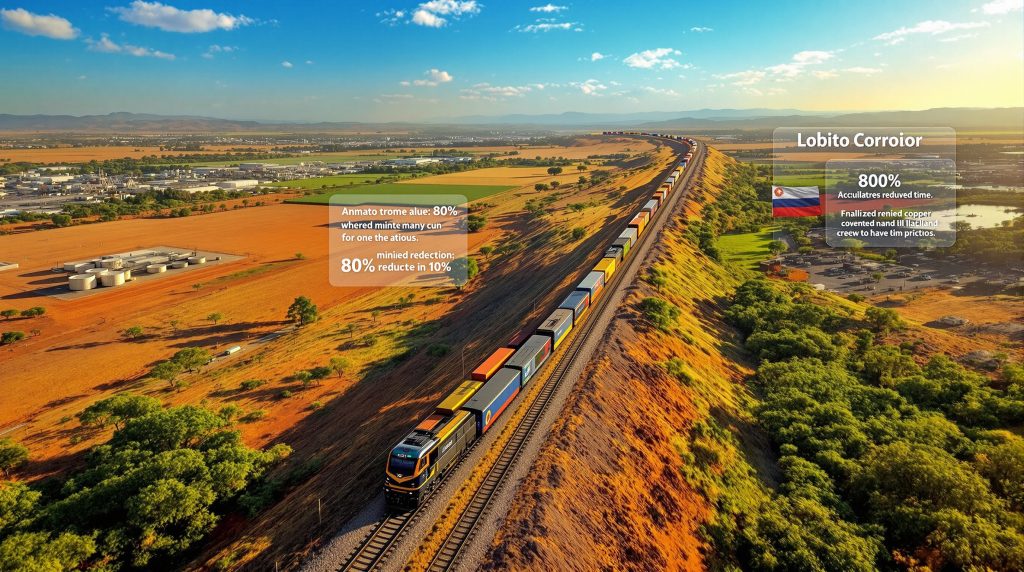The Lobito Corridor: Reshaping African Trade Routes and Economic Development
What Makes the Lobito Corridor a Strategic Trade Gateway?
The Lobito Corridor represents one of Africa's most significant infrastructure revivals, connecting Angola's Atlantic port city of Lobito to the mineral-rich regions of the Democratic Republic of Congo (DRC) and Zambia. This 1,300-kilometer railway system provides a direct western export pathway that fundamentally changes trade dynamics across central Africa.
Unlike traditional export routes that funnel minerals through southern or eastern Africa, the Lobito Corridor creates a shorter, more direct link to global markets. This western-facing route reduces transport times dramatically, offering unprecedented efficiency for exporters and importers throughout the region.
The corridor's strategic importance extends beyond physical infrastructure—it represents a new geopolitical alignment in Africa's development narrative. By offering an alternative to traditional eastern export routes, it diversifies supply chains and strengthens regional integration within the broader context of the evolution of mining trends.
The Geographic Advantage
The corridor's location provides a natural competitive edge. It connects Angola's deep-water Atlantic port directly to the copper-rich Katanga province in the DRC and extends toward Zambia's mining regions. This positioning creates the shortest possible route from these mineral-rich areas to global markets across the Atlantic.
The western orientation provides African producers with faster access to European and North American markets, while simultaneously streamlining imports of essential goods and equipment flowing into the continent's interior.
For mining companies operating in the Copperbelt region, this geographical advantage translates to reduced logistics costs, more predictable export schedules, and decreased working capital requirements. This is particularly significant for mineral exploration in copper and other critical minerals.
From Historical Railway to Modern Trade Artery
The corridor's backbone—the historic Benguela Railway—has undergone extensive rehabilitation after falling into disrepair during decades of regional conflict. Today's revitalized system combines restored infrastructure with modern operational practices.
"What we want to achieve is to offer a new corridor option for the minerals from DRC, a new, shorter and cheaper solution for export and import minerals, but also other cargo from Lobito to DRC, from DRC to Lobito," explains Nicolas Gregoire, Chief Operating Officer of Lobito Atlantic Railway.
The transformation from dormant colonial-era infrastructure to modern trade artery represents a remarkable turnaround. Modern signaling systems, improved track infrastructure, and contemporary operational practices have breathed new life into this historic route.
How is the Corridor Transforming Mineral Export Dynamics?
Creating New Pathways for Critical Minerals
The corridor is already handling significant volumes of copper cathodes from the DRC's mining operations. This marks just the beginning of its potential, as capacity continues to expand and operational efficiency improves.
Copper and cobalt exports—critical minerals essential for global energy transition technologies—now have a more direct route to international markets. This is particularly important as copper demand surge insights indicate continued growth, driven by electric vehicle production and renewable energy infrastructure development.
The transport efficiency gain is substantial. While traditional routes through southern or eastern Africa could take 30+ days to reach port facilities, early operational data suggests the Lobito Corridor can reduce this to approximately one week—an 80% reduction in transit time.
Beyond One-Way Traffic: The Import Revolution
The corridor functions as a bidirectional trade facilitator, creating a balanced flow that enhances economic sustainability.
"Out is copper, copper cathode and on imports, it has been mainly sulfur," notes Gregoire. This highlights how the corridor supports the mining industry in both directions—exporting finished products while bringing in essential processing materials.
Beyond mining supplies, the corridor is positioned to transform import dynamics for agricultural inputs, manufacturing equipment, and consumer goods. This two-way flow creates a sustainable economic model that benefits all participating countries.
"In the future it will probably be as well fuel, lubricants, any of the other equipment that we can bring to DRC for the need of the Katanga regions. We need to develop also the domestic market in Angola," explains Gregoire, highlighting the diversification strategy.
What Operational Innovations Drive the Corridor's Success?
The Containerization Strategy
One of the most significant operational advances is the shift toward containerized cargo transport. This represents a fundamental improvement over traditional bulk shipping methods that have dominated African mineral exports.
"Containerized cargo is done door to door… The best way would be containerized business. That's really what we want to achieve because there's no risk of impact on the environment. There's no risk of security, less risk in safety," emphasizes Gregoire.
The advantages of containerization include:
- Reduced environmental risks through sealed transport
- Enhanced security for high-value minerals
- Faster loading/unloading cycles (hours versus days)
- Improved asset utilization throughout the system
- Standardized handling that improves intermodal connections
This shift represents a modernization of Africa's mineral transport systems, bringing them in line with global best practices and increasing overall supply chain resilience.
Open-Access Business Model
Unlike some infrastructure initiatives that restrict usage, the Lobito Corridor operates on an inclusive basis that welcomes diverse participants.
"It's a non-exclusive concession contract and all customers that are interested in transporting with us, we will take on board," states Gregoire. This open-access approach ensures the corridor serves as a genuine public good rather than a restricted channel.
The non-exclusive model creates several important benefits:
- Increased competition that drives down transport costs
- Maximized utilization of the infrastructure
- Wider economic benefits across multiple sectors
- More inclusive regional development
This approach stands in contrast to more restrictive models sometimes implemented in resource corridors, where access may be limited to specific companies or countries.
What Are the Corridor's Growth Targets and Development Vision?
Ambitious Volume Objectives
The corridor's operators have established clear volume objectives that demonstrate confidence in its transformative potential:
"Now if you look five years from now, what we would like to do is to achieve 1 million tons of export, 1 million tons of import, and probably 500,000 tons on the domestic market," states Gregoire.
These targets—totaling 2.5 million tons annually—would represent a significant portion of the region's transport capacity and create substantial economic impact throughout the corridor.
Achieving these volumes will require continued investment in rolling stock, operational capacity, and port facilities. It also necessitates strong coordination between the corridor operators and mining companies to ensure synchronized production and transport planning.
Beyond Minerals: Diversifying Cargo Profiles
While mineral exports currently dominate corridor traffic, the long-term vision includes significant cargo diversification:
- Agricultural products to support food security and export opportunities
- Construction materials for regional development projects
- Manufacturing inputs to support industrial growth
- Consumer goods to serve growing regional markets
This diversification strategy reduces dependency on mineral markets and creates a more resilient economic model. It also extends the corridor's benefits beyond mining regions to agricultural and manufacturing centers throughout Angola, DRC, and Zambia.
How Does the Corridor Address Community and Safety Concerns?
Comprehensive Safety Framework
Operating a 1,300-kilometer railway through diverse regions requires robust safety systems. The corridor has implemented a comprehensive approach that distinguishes between different safety domains.
"Safety is important and we make a big difference between occupational safety and railway safety… running a railway over 1,300 kilometers, we need to speak about railway safety," explains Gregoire.
This dual focus ensures both worker safety and community protection along the entire route. The safety framework includes:
- Worker training and protective equipment standards
- Community awareness campaigns about railway hazards
- Specialized procedures for handling hazardous materials
- Modern signaling systems and operating protocols
- Incident response plans for the entire corridor
These safety measures are essential for maintaining community support and ensuring operational sustainability, aligning with the broader mining sustainability transformation occurring across the industry.
Local Economic Integration Strategies
The corridor's long-term success depends on positive integration with local economies along its route. This includes both employment opportunities and skills development.
"And also to add value to the local market here in Angola, and to grow our local staff and for them to take over some of the key management positions in the coming years," notes Gregoire.
This focus on local capacity building includes:
- Direct employment in railway and port operations
- Supporting logistics and service industries
- Skills transfer programs for local management development
- Specialized training for technical roles
- Integration with local educational institutions
These integration strategies ensure the corridor generates broad-based economic benefits rather than functioning as an isolated export channel, contributing to South Africa beneficiation opportunities and similar initiatives across the region.
What Future Developments Will Enhance the Corridor's Impact?
Infrastructure Expansion Plans
The current corridor represents just the initial phase of a larger regional vision. Future expansion plans include:
- Extending rail connections to additional mining regions
- Increasing train lengths and frequency
- Modernizing signaling and control systems
- Expanding port handling capacity at Lobito
- Developing intermodal connections to road networks
These expansions will further enhance the corridor's capacity and extend its economic impact to new regions. They represent significant investment opportunities for both public and private sector participants.
Value Addition Opportunities
Beyond transport efficiency, the corridor creates opportunities for increased in-country processing and manufacturing:
- Supporting the development of local refining capacity
- Creating opportunities for downstream industries
- Reducing the export of raw materials in favor of processed products
- Enabling industrial clusters along the corridor route
By reducing logistics costs and improving reliability, the corridor makes local processing more economically viable, helping countries capture greater value from their natural resources.
FAQ: Understanding the Lobito Corridor's Regional Significance
How does the Lobito Corridor compare to other African trade routes?
The Lobito Corridor provides one of the most direct routes from central Africa's mining regions to global markets. It offers approximately 80% time savings compared to traditional southern routes through South Africa or eastern routes through Tanzania. This dramatic efficiency gain creates significant competitive advantages for exporters and importers utilizing the corridor.
What types of cargo currently dominate the corridor's operations?
Copper cathodes currently lead the corridor's export profile, while sulfur for mining operations represents a significant import category. This reflects the corridor's initial focus on serving the mining industry, though diversification efforts are underway to expand into agricultural products, fuel, lubricants, and other essential goods for regional markets.
How does the corridor benefit local economies beyond mining?
The corridor creates multiple benefits for non-mining sectors, including reduced transport costs for agricultural exports, improved access to imported inputs for manufacturing, and enhanced distribution networks for consumer goods. It also generates employment in transport, logistics, and support services while creating opportunities for skills development and management training.
What role does containerization play in the corridor's operations?
Containerization represents a fundamental operational improvement over traditional bulk transport methods. It enhances security for high-value minerals, reduces environmental risks, and dramatically increases operational efficiency through faster loading/unloading cycles. The sealed nature of containers also improves product quality protection for both exports and imports, creating benefits throughout the supply chain.
Further Exploration
Readers interested in African trade infrastructure can explore related educational content from Fastmarkets, including their Fast Forward podcast which features on-the-ground reporting about the Lobito Corridor and other critical mineral supply chains. This podcast provides valuable insights into the corridor's operations and its role in reshaping African trade patterns.
For a comprehensive overview of regional development initiatives, the UNDP's policy brief on the Lobito Corridor offers valuable insights into the strategic importance of this transformative project for sustainable development across central Africa.
Want to Discover the Next Major ASX Mineral Find Before the Market Does?
Don't miss out on the next potentially transformative discovery—subscribe to Discovery Alert's proprietary Discovery IQ model that delivers instant notifications when significant mineral discoveries are announced on the ASX. Explore historic discovery returns and position yourself ahead of the market by visiting https://discoveryalert.com.au/discoveries/ today.




